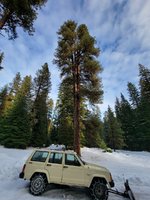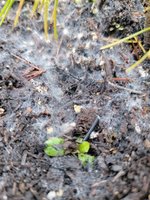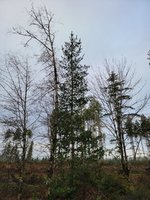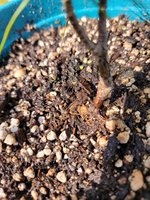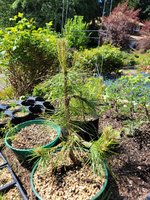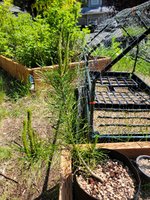You are using an out of date browser. It may not display this or other websites correctly.
You should upgrade or use an alternative browser.
You should upgrade or use an alternative browser.
Diving into Bonsai
- Thread starter TacomaBonsai95
- Start date
penumbra
Imperial Masterpiece
I am not meaning to sound discouraging, but I think that what you are seeing as mycorrhiza may in fact be mold. The potting mix you are showing seems to be rather wet and heavy and may encourage mold, especially if it is as full of organics as it seems to be.
TacomaBonsai95
Mame
It's a tree that I moved from my friends property last week so that's just the soil it came out of the woods with. Maybe some of the soil has organic matter breaking down. The soil around the edges of the pot is some top soil from the woods nearby. Here's a close up.
Attachments
Adamski77
Chumono
Agree with penumbra… it does look like mold as oppose to mycorrhizae. Had something similar going on with my podocarpus cuttings when left them in organic soil in a little greenhouse.
Maiden69
Masterpiece
Could be mycelium or dollar spot fungus or something similar. I get some on my lawn once in a while
MaciekA
Shohin
edit: (this post is a response to OP talking about fungal issues in WWP in general, not related to fungus/mold on top of soil)
I want to ease your fears about WWP having "fungal issues" a little bit. Most pine species (whether five needle or not) in the western US have within their populations some degree of stress from fungal issues. Western white pine, whitebark pine, lodgepole pine, etc. But when you're in complete horticultural control of a pine, you can reduce or eliminate your risk.
A lot of the fungus-induced deaths in WWP + whitebark result from a stack of accumulating stresses: First they get weak, then they're attacked by beetles, then the beetles import the fungal spores en masse into the interiors of trees. Combinations of regional warming and/or high-intensity fires (as opposed to low intensity beneficial fire) that modify the environment then add to the problem and also reduce recruitment (i.e. seedlings that would otherwise be cooled by a denser canopy get roasted in a hot dry wasteland). When you read about WWP you're mostly going to run into literature that is concerned with this dynamic in the wild.
Wild conditions don't resemble the horticultural setup of a WWP / WBP / LPP / limber / etc in a bonsai garden in the Pacific Northwest because you control so many factors that can avoid that stack of stresses getting established in the first place.
You can have good success if:
- You're caught up on what kind of potting pines prefer to be recovered and grown in -- pumice is insanely cheap in the PNW and a grow box or pond basket isn't hard to find or build. Pines roots want to breathe air. Five-needle and high elevation pines in general take much longer to grow roots, so when choosing media you need to choose for longevity and not a preconceived notion of "trees eat dirt therefore I need some dirt in there". The most superlative health results I have with pine are in pure inorganic volcanic media. Look at what every professional who handles very expensive yamadori in the western US pots high elevation pines into and you will find pumice.
- You grow in full sun
- You don't go wild with fertilizers or biological additives without understanding what that might do to the root/soil environment when there still aren't that many roots
- You're there to watch for insect attacks and maybe apply things like lime sulphur to kill off eggs and spores in the dormant season if there is a concern
- You follow the rule #1 with pine bonsai which is: Let them build up physical mass and obvious signs of vigor, acceleration, momentum before coming back to work on them
Keep the following thought in a time capsule IF you do end up having a WWP turn brown after collection: A collected WWP is a million times more likely to die due to poor recovery practices and poor potting than from a fungus. The very first WWP I collected didn't survive, and at the time I remember reading about fungal issues. In retrospect years later, it's blazingly obvious what I did wrong (crap potting, overly-shady recovery location). Collecting young individuals of western pines should technically be low risk as long as you have all your pine horticulture checkboxes checked.
Keep em in the sun, don't move them much or at all, don't let them get bit by overnight freezes until they've had a full summer+fall to grow new roots, don't water them too often, don't wire/work/prune/etc for a couple years and you should be a WWP grower in no time
I want to ease your fears about WWP having "fungal issues" a little bit. Most pine species (whether five needle or not) in the western US have within their populations some degree of stress from fungal issues. Western white pine, whitebark pine, lodgepole pine, etc. But when you're in complete horticultural control of a pine, you can reduce or eliminate your risk.
A lot of the fungus-induced deaths in WWP + whitebark result from a stack of accumulating stresses: First they get weak, then they're attacked by beetles, then the beetles import the fungal spores en masse into the interiors of trees. Combinations of regional warming and/or high-intensity fires (as opposed to low intensity beneficial fire) that modify the environment then add to the problem and also reduce recruitment (i.e. seedlings that would otherwise be cooled by a denser canopy get roasted in a hot dry wasteland). When you read about WWP you're mostly going to run into literature that is concerned with this dynamic in the wild.
Wild conditions don't resemble the horticultural setup of a WWP / WBP / LPP / limber / etc in a bonsai garden in the Pacific Northwest because you control so many factors that can avoid that stack of stresses getting established in the first place.
You can have good success if:
- You're caught up on what kind of potting pines prefer to be recovered and grown in -- pumice is insanely cheap in the PNW and a grow box or pond basket isn't hard to find or build. Pines roots want to breathe air. Five-needle and high elevation pines in general take much longer to grow roots, so when choosing media you need to choose for longevity and not a preconceived notion of "trees eat dirt therefore I need some dirt in there". The most superlative health results I have with pine are in pure inorganic volcanic media. Look at what every professional who handles very expensive yamadori in the western US pots high elevation pines into and you will find pumice.
- You grow in full sun
- You don't go wild with fertilizers or biological additives without understanding what that might do to the root/soil environment when there still aren't that many roots
- You're there to watch for insect attacks and maybe apply things like lime sulphur to kill off eggs and spores in the dormant season if there is a concern
- You follow the rule #1 with pine bonsai which is: Let them build up physical mass and obvious signs of vigor, acceleration, momentum before coming back to work on them
Keep the following thought in a time capsule IF you do end up having a WWP turn brown after collection: A collected WWP is a million times more likely to die due to poor recovery practices and poor potting than from a fungus. The very first WWP I collected didn't survive, and at the time I remember reading about fungal issues. In retrospect years later, it's blazingly obvious what I did wrong (crap potting, overly-shady recovery location). Collecting young individuals of western pines should technically be low risk as long as you have all your pine horticulture checkboxes checked.
Keep em in the sun, don't move them much or at all, don't let them get bit by overnight freezes until they've had a full summer+fall to grow new roots, don't water them too often, don't wire/work/prune/etc for a couple years and you should be a WWP grower in no time
Last edited:
TacomaBonsai95
Mame
Wow, thank you for the information. One of the weird things I've been noticing in my area is that WWP grows in low elevation forests that are very wet. Here's where I got it from,edit: (this post is a response to OP talking about fungal issues in WWP in general, not related to fungus/mold on top of soil)
I want to ease your fears about WWP having "fungal issues" a little bit. Most pine species (whether five needle or not) in the western US have within their populations some degree of stress from fungal issues. Western white pine, whitebark pine, lodgepole pine, etc. But when you're in complete horticultural control of a pine, you can reduce or eliminate your risk.
A lot of the fungus-induced deaths in WWP + whitebark result from a stack of accumulating stresses: First they get weak, then they're attacked by beetles, then the beetles import the fungal spores en masse into the interiors of trees. Combinations of regional warming and/or high-intensity fires (as opposed to low intensity beneficial fire) that modify the environment then add to the problem and also reduce recruitment (i.e. seedlings that would otherwise be cooled by a denser canopy get roasted in a hot dry wasteland). When you read about WWP you're mostly going to run into literature that is concerned with this dynamic in the wild.
Wild conditions don't resemble the horticultural setup of a WWP / WBP / LPP / limber / etc in a bonsai garden in the Pacific Northwest because you control so many factors that can avoid that stack of stresses getting established in the first place.
You can have good success if:
- You're caught up on what kind of potting pines prefer to be recovered and grown in -- pumice is insanely cheap in the PNW and a grow box or pond basket isn't hard to find or build. Pines roots want to breathe air. Five-needle and high elevation pines in general take much longer to grow roots, so when choosing media you need to choose for longevity and not a preconceived notion of "trees eat dirt therefore I need some dirt in there". The most superlative health results I have with pine are in pure inorganic volcanic media. Look at what every professional who handles very expensive yamadori in the western US pots high elevation pines into and you will find pumice.
- You grow in full sun
- You don't go wild with fertilizers or biological additives without understanding what that might do to the root/soil environment when there still aren't that many roots
- You're there to watch for insect attacks and maybe apply things like lime sulphur to kill off eggs and spores in the dormant season if there is a concern
- You follow the rule #1 with pine bonsai which is: Let them build up physical mass and obvious signs of vigor, acceleration, momentum before coming back to work on them
Keep the following thought in a time capsule IF you do end up having a WWP turn brown after collection: A collected WWP is a million times more likely to die due to poor recovery practices and poor potting than from a fungus. The very first WWP I collected didn't survive, and at the time I remember reading about fungal issues. In retrospect years later, it's blazingly obvious what I did wrong (crap potting, overly-shady recovery location). Collecting young individuals of western pines should technically be low risk as long as you have all your pine horticulture checkboxes checked.
Keep em in the sun, don't move them much or at all, don't let them get bit by overnight freezes until they've had a full summer+fall to grow new roots, don't water them too often, don't wire/work/prune/etc for a couple years and you should be a WWP grower in no time

They're all mixed in with the rhododendrons at about 600 ft elevation in tahuya state forest. Some of them are growing out of the gravel, some in the forest.
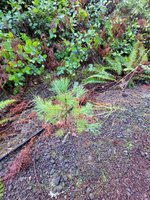
I figured I would do some reading and repot it in the spring because I removed the whole tree without disturbing almost any of the roots and don't wanna stress it.
PowerTap
Shohin
Are you recommending transitioning these trees to pure pumice in one season?You're caught up on what kind of potting pines prefer to be recovered and grown in -- pumice is insanely cheap in the PNW and a grow box or pond basket isn't hard to find or build. Pines roots want to breathe air. Five-needle and high elevation pines in general take much longer to grow roots, so when choosing media you need to choose for longevity and not a preconceived notion of "trees eat dirt therefore I need some dirt in there". The most superlative health results I have with pine are in pure inorganic volcanic media. Look at what every professional who handles very expensive yamadori in the western US pots high elevation pines into and you will find pumice.
I've read you needed a slower transition with pines so their root microbiom can populate the new soil as you get rid of the organic nursery or natural soil.
Deep Sea Diver
Imperial Masterpiece
Hmm…
It depends on the age and health. I have done so with youngish pines and they haven’t skipped a beat. It is prudent practice to include a small amount of the previous media with the new media, thus inoculating the new media with the various mocrobes it’s used to. Adding biochar helps build the rhizosphere too, giving these microbes places to build their populations and a bit of various micronutrients.
Old pines are a different story. Then it’s easy does it…. usually.
cheers
DSD sends
It depends on the age and health. I have done so with youngish pines and they haven’t skipped a beat. It is prudent practice to include a small amount of the previous media with the new media, thus inoculating the new media with the various mocrobes it’s used to. Adding biochar helps build the rhizosphere too, giving these microbes places to build their populations and a bit of various micronutrients.
Old pines are a different story. Then it’s easy does it…. usually.
cheers
DSD sends
TacomaBonsai95
Mame
Once spring time comes around I might do some root work/ move into a better pot with better growing medium. I am worried about moving it into anything that drys out to quickly because of the area where these trees come from. They are from the olympic rainforest and were collected from a forest understory that was heavily populated with rhododendrons as well as western white pines. Here's the location.
Attachments
MaciekA
Shohin
Are you recommending transitioning these trees to pure pumice in one season?
I've read you needed a slower transition with pines so their root microbiom can populate the new soil as you get rid of the organic nursery or natural soil.
What @Deep Sea Diver said in the above comment is what I do, with the goal to get roots growing in pumice. If it's a seedling, I bare root. If it's an autumn collection, I use a heat mat until spring (no heat mat if summer collection). If it's a much larger tree, I blend as DSD mentioned.
TacomaBonsai95
Mame
Thank you! So far I have purchased a small greenhouse (just to control how much rain we get). I put all my collected trees in their and I have heating coils under the dirt that keep Temps above freezing, but below 40 when outside temp is below.What @Deep Sea Diver said in the above comment is what I do, with the goal to get roots growing in pumice. If it's a seedling, I bare root. If it's an autumn collection, I use a heat mat until spring (no heat mat if summer collection). If it's a much larger tree, I blend as DSD mentioned.
JackHammer
Chumono
I have a jbp that is from nursery stock. I did a trunk chop and dropped the root ball in pumice gravel and pinebark. Now each spring, I flip the root ball to the other side of the pot so it is at an angle. Over the summer, the root ball washes away, air prunes the roots and slowly does an exposed root.What @Deep Sea Diver said in the above comment is what I do, with the goal to get roots growing in pumice. If it's a seedling, I bare root. If it's an autumn collection, I use a heat mat until spring (no heat mat if summer collection). If it's a much larger tree, I blend as DSD mentioned.
TacomaBonsai95
Mame
TacomaBonsai95
Mame
TacomaBonsai95
Mame
Millard B.
Yamadori
Greetings,
There is a lot of good advice presented here, we are at opposite corners of the country but bonsai is bonsai. I find that the majority of my tried and true friends are from the bonsai community. I like to live with a new store bought or collected yamadori tree for a while before starting the process of removing the bad and refining the good. As a retired plumbing contractor I like to have a plan of sorts to work off of, a Blueprint. I totally agree with Deep Sea Diver, join a local club to get constructive criticism on the many different view points of what to do with your tree, I belong to three clubs, Boca Raton, WPB, and Treasure Coast. When a workshop is being held, unless you have a really good tree to bring and have the master help you work on, rather go as an observer to see all the different solutions. If you bring in a workshop tree you will be focused on only your tree, while the master is helping the other dozen or so people work on their trees. Just because a visiting master says to do this or that, hold back if you dont feel that it is the best solution. In 1979 I attended a workshop with an old Bucida spinosa from the Bahamas, it had a dozen different ways to style it. A good friend from my home club suggested to me that I make a shohin bonsai from it. The old oriental master had a different idea and made a reverse windswept corkscrew style from it chopping off the potential shohin apex. I worked on this tree for 38 years before borers got into the scar from removing the potential apex killing the tree stone dead. The traveling master was a guy named John Naka ! In June 1980 I flew to SeaTac to visit a girlfriend about a month after Mt. St. Hellens blew it's top, I never saw so much ash, it ruined the windshield. We traveled all over the state, while crossing the Cascades near Mt Index we stopped at a roadside sign "Bonsai For Sale". I bought an ancient Dwarf Alberta Spruce about 30" tall for $100- a real deal! I bought a hand saw, plywood, 2"x2"s, screws- then air freighted it to Miami International. At the time I did not know anything about USDA Zones, this was a lesson learned hard. It took only one hot South Florida Summer to kill ir stone dead. This spring I just bought 18 more JBPs in 4"pots to add to the 45 JBPs from a grafting expierment, grafting Pinus clausa witches brooms onto, the Pinus clausa has 1.25" full sized needles! Like Deep Sea Diver I once in a previous lifetime was a commercial Spiny Lobster diver, it is a hard way to make a living!
Respectfully Submitted
If You Ain't having Fun Doing What You"re Doing, You're Doing It Wrong!
There is a lot of good advice presented here, we are at opposite corners of the country but bonsai is bonsai. I find that the majority of my tried and true friends are from the bonsai community. I like to live with a new store bought or collected yamadori tree for a while before starting the process of removing the bad and refining the good. As a retired plumbing contractor I like to have a plan of sorts to work off of, a Blueprint. I totally agree with Deep Sea Diver, join a local club to get constructive criticism on the many different view points of what to do with your tree, I belong to three clubs, Boca Raton, WPB, and Treasure Coast. When a workshop is being held, unless you have a really good tree to bring and have the master help you work on, rather go as an observer to see all the different solutions. If you bring in a workshop tree you will be focused on only your tree, while the master is helping the other dozen or so people work on their trees. Just because a visiting master says to do this or that, hold back if you dont feel that it is the best solution. In 1979 I attended a workshop with an old Bucida spinosa from the Bahamas, it had a dozen different ways to style it. A good friend from my home club suggested to me that I make a shohin bonsai from it. The old oriental master had a different idea and made a reverse windswept corkscrew style from it chopping off the potential shohin apex. I worked on this tree for 38 years before borers got into the scar from removing the potential apex killing the tree stone dead. The traveling master was a guy named John Naka ! In June 1980 I flew to SeaTac to visit a girlfriend about a month after Mt. St. Hellens blew it's top, I never saw so much ash, it ruined the windshield. We traveled all over the state, while crossing the Cascades near Mt Index we stopped at a roadside sign "Bonsai For Sale". I bought an ancient Dwarf Alberta Spruce about 30" tall for $100- a real deal! I bought a hand saw, plywood, 2"x2"s, screws- then air freighted it to Miami International. At the time I did not know anything about USDA Zones, this was a lesson learned hard. It took only one hot South Florida Summer to kill ir stone dead. This spring I just bought 18 more JBPs in 4"pots to add to the 45 JBPs from a grafting expierment, grafting Pinus clausa witches brooms onto, the Pinus clausa has 1.25" full sized needles! Like Deep Sea Diver I once in a previous lifetime was a commercial Spiny Lobster diver, it is a hard way to make a living!
Respectfully Submitted
If You Ain't having Fun Doing What You"re Doing, You're Doing It Wrong!


